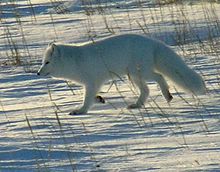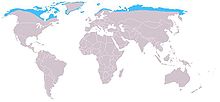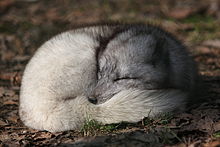- Arctic fox
-
For other uses, see Arctic fox (disambiguation).
Arctic fox[1] 
Conservation status Scientific classification Kingdom: Animalia Phylum: Chordata Class: Mammalia Order: Carnivora Family: Canidae Genus: Vulpes Species: V. lagopus Binomial name Vulpes lagopus
Linnaeus, 1758[2]
Arctic fox range Synonyms Alopex lagopus
Canis lagopusThe arctic fox (Vulpes lagopus,[2] formerly known as Alopex lagopus), also known as the white fox, polar fox or snow fox, is a small fox native to Arctic regions of the Northern Hemisphere and is common throughout the Arctic tundra biome. The Greek word alopex, (ἀλώπηξ) means a fox and Vulpes is the Latin version. Lagopus is derived from Ancient Greek lago (λαγως), meaning "hare", + pous (πους), "foot" and refers to the hair on its feet.[3][4] Although it has previously been assigned to its own genus Alopex, genetic evidence places it in Vulpes (Mammal Species of the World) with the majority of the other foxes.[1][5]
Contents
Adaptations
The arctic fox lives in some of the most frigid extremes on the planet. Among its adaptations for cold survival are its deep, thick fur,[6] a system of countercurrent heat exchange in the circulation of paws to retain core temperature, and a good supply of body fat. The fox has a low surface area to volume ratio, as evidenced by its generally rounded body shape, short muzzle and legs, and short, thick ears. Since less of its surface area is exposed to the arctic cold, less heat escapes the body. Its furry paws allow it to walk on ice in search of food. The arctic fox has such keen hearing that it can precisely locate the position of prey under the snow. When it finds prey, it pounces and punches through the snow to catch its victim. Its fur changes colour with the seasons: in the winter it is white to blend in with snow, while in the summer months it changes to brown.[7]
Reproduction
The arctic fox tends to be active from early September to early May. The gestation period is 52 days. Litters tend to average 5-8 kits but may be as many as 25[8](the largest in the order Carnivora[9] ) Both the mother and the father help to raise their young. The females leave the family and form their own groups and the males stay with the family.
Foxes tend to form monogamous pairs in the breeding season. Litters are born in the early summer and the parents raise the young in a large den. Dens can be complex underground networks, housing many generations of foxes. Young from a previous year's litter may stay with the parents to help rear younger siblings.[8] The kits are initially brownish; as they become older they turn white. Their coat of fur also changes color when summer arrives but in winter it is white.
Diet
The arctic fox will generally eat any small animal it can find: lemmings, hares, owls, eggs, and carrion, etc. Lemmings are the most common prey. A family of foxes can eat dozens of lemmings each day. During April and May the arctic fox also preys on ringed seal pups when the young animals are confined to a snow den and are relatively helpless. Fish beneath the ice are also part of its diet. If there is an overabundance of food hunted, the arctic fox will bury what the family cannot eat. When its normal prey is scarce, the arctic fox scavenges the leftovers and even feces of larger predators, such as the polar bear, even though the bear's prey includes the arctic fox itself.
Size
The average length is 85.3 cm (33.6 in), with a range of 80 to 110 cm (31 to 43 in), in the male and 82.1 cm (32.3 in), with a range of 71.3 to 85 cm (28.1 to 33 in), in the female.[10] The tail is 31 cm (12.2 in) long in the male and 30 cm (11.8 in) long in the female. It is 25–30 cm (9.8–11.8 in) high at the shoulder.[11] On average males weigh 3.5 kg (7.7 lb), with a range of 3.2 to 9.4 kg (7.1 to 21 lb), while females average 2.9 kg (6.4 lb), with a range of 1.4 to 3.2 kg (3.1 to 7.1 lb).[10]
Subspecies
Besides the nominate, Vulpes lagopus lagopus, there are four subspecies of this fox:
- Bering Islands arctic fox, Vulpes lagopus beringensis
- Iceland Arctic fox, Vulpes lagopus fuliginosus
- Pribilof Islands arctic fox, Vulpes lagopus pribilofensis
- Greenland arctic fox, Vulpes lagopus foragorapusis
Population and distribution
The arctic fox has a circumpolar range, meaning that it is found throughout the entire Arctic, including the outer edges of Greenland, Russia, Canada, Alaska, and Svalbard, as well as in Subarctic and alpine areas, such as Iceland and mainland alpine Scandinavia. The conservation status of the species is good, except for the Scandinavian mainland population. It is acutely endangered there, despite decades of legal protection from hunting and persecution. The total population estimate in all of Norway, Sweden and Finland is a mere 120 adult individuals.
The arctic fox is the only native land mammal to Iceland.[12] It came to the isolated North Atlantic island at the end of the last ice age, walking over the frozen sea. The Arctic Fox Center in Súðavík contains an exhibition on the arctic fox and conducts studies on the influence of tourism on the population.[13]
The abundance of the arctic fox species tends to fluctuate in a cycle along with the population of lemmings. Because the fox reproduces very quickly and often dies young, population levels are not seriously impacted by trapping. The arctic fox has, nonetheless, been eradicated from many areas where humans are settled.
The pelts of arctic foxes with a slate blue coloration - an expression of a recessive gene - were especially valuable. They were transported to various previously fox-free Aleutian Islands during the 1920s. The program was successful in terms of increasing the population of blue foxes, but their predation of Aleutian Canadian geese conflicted with the goal of preserving that species.[14]
The arctic fox is losing ground to the larger red fox. Historically, the gray wolf has kept red fox numbers down, but as the wolf has been hunted to near extinction in much of its former range, the red fox population has grown larger, and it has taken over the niche of top predator. In areas of northern Europe there are programs in place that allow hunting of the red fox in the arctic fox's previous range.
As with many other game species, the best sources of historical and large scale population data are hunting bag records and questionnaires. There are several potential sources of error in such data collections.[15] In addition, numbers vary widely between years due to the large population fluctuations. However, the total population of the arctic fox must be in the order of several hundred thousand animals.[16]
The world population is thus not endangered, but two arctic fox subpopulations are. One is on Medny Island (Commander Islands, Russia), which was reduced by some 85-90%, to around 90 animals, as a result of mange caused by an ear tick introduced by dogs in the 1970s.[17] The population is currently under treatment with antiparasitic drugs, but the result is still uncertain.
The other threatened population is the one in Fennoscandia (Norway, Sweden, Finland and Kola Peninsula). This population decreased drastically around the start of the 20th century as a result of extreme fur prices which caused severe hunting also during population lows.[18] The population has remained at a low density for more than 90 years, with additional reductions during the last decade.[19] The total population estimate for 1997 is around 60 adults in Sweden, 11 adults in Finland and 50 in Norway. From Kola, there are indications of a similar situation, suggesting a population of around 20 adults. The Fennoscandian population thus numbers a total of 140 breeding adults. Even after local lemming peaks, the arctic fox population tends to collapse back to levels dangerously close to non-viability.[16]
References
- ^ a b Wozencraft, W. Christopher (16 November 2005). "Order Carnivora (pp. 532-628)". In Wilson, Don E., and Reeder, DeeAnn M., eds. Mammal Species of the World: A Taxonomic and Geographic Reference (3rd ed.). Baltimore: Johns Hopkins University Press, 2 vols. (2142 pp.). ISBN 978-0-8018-8221-0. OCLC 62265494. http://www.bucknell.edu/msw3/browse.asp?id=14000873.
- ^ a b c Angerbjörn, A., Hersteinsson, P. & Tannerfeldt, M. (2008). Alopex lagopus. In: IUCN 2008. IUCN Red List of Threatened Species. Downloaded on 11 February 2009.
- ^ Alopex lagopus
- ^ Vulpes zerda
- ^ Bininda-Emonds, ORP; JL Gittleman, A Purvis (1999). "Building large trees by combining phylogenetic information: a complete phylogeny of the extant Carnivora (Mammalia)" (PDF). Biol. Rev. 74 (2): 143–175. doi:10.1017/S0006323199005307. PMID 10396181. http://www.daimi.au.dk/~cmosses/thesis/articles/Bininda_Emonds_Carnivora.pdf. Retrieved 2008-07-30.[dead link]
- ^ Canids: Foxes, Wolves, Jackals and Dogs
- ^ Arctic Fox Alopex lagopus
- ^ a b Dewey, T. and C. Middlebrook. 2007. "Vulpes lagopus" (On-line). Accessed May 16, 2009 at Animal Diversity Web
- ^ MacDonald, David W. (2004). Biology and Conservation of Wild Canids. Oxford University Press. ISBN 0-19-851556-1.
- ^ a b Alopex lagopus at the Smithsonian
- ^ Boitani, Luigi, Simon & Schuster's Guide to Mammals. Simon & Schuster/Touchstone Books (1984), ISBN 978-0671428051
- ^ "Wildlife". Iceland Worldwide. iww.is. 2000. http://www.iww.is/pages/alife/biglf.html. Retrieved 22 April 2010.
- ^ "The Arctic Fox Center". http://www.arcticfoxcenter.com/. Retrieved May 19, 2011.
- ^ Eric G. Bolen (1998). Ecology of North America. John Wiley and Sons. p. 42. ISBN 9780471131564. http://books.google.com/?id=sbYL7JNnMNIC&pg=PA42&dq=arctic+fox+blue+phase#v=onepage&q=arctic%20fox%20blue%20phase&f=false.
- ^ Garrott and Eberhardt (1987). "Arctic fox". In Novak, M. et al. (eds.). Wild furbearer management and conservation in North America. pp. 395–406.
- ^ a b Tannerfeldt, M. (1997). Population fluctuations and life history consequences in the Arctic fox.. Stockholm, Sweden: Dissertation, Stockholm University.
- ^ Goltsman et al.; Kruchenkova, E. P.; MacDonald, D. W. (1996). "The Mednyi Arctic foxes: treating a population imperilled by disease". Oryx 30 (04): 251–258. doi:10.1017/S0030605300021748.
- ^ Lönnberg, E. (1927). Fjällrävsstammen i Sverige 1926. Uppsala, Sweden: Royal Swedish Academy of Sciences.
- ^ Angerbjörn, A. et al. (1995). "Dynamics of the Arctic fox population in Sweden". Annales Zoologici Fennici 32: 55–68.
- Nowak, Ronald M. (2005). Walker's Carnivores of the World. Baltimore: Johns Hopkins Press. ISBN 0-8018-8032-7
- "Vulpes lagopus". Integrated Taxonomic Information System. http://www.itis.gov/servlet/SingleRpt/SingleRpt?search_topic=TSN&search_value=622025. Retrieved 24 February 2009.
External links
- State of the Environment Norway: Arctic fox
- Smithsonian Institution - North American Mammals: Vulpes lagopus
Categories:- IUCN Red List least concern species
- Arctic land animals
- Foxes
- Mammals of North America
- Mammals of Europe
- Mammals of Iceland
- Fauna of Greenland
- Fauna of Iceland
- Fauna of Russia
- Megafauna of North America
- Megafauna of Eurasia
- Animals described in 1758
Wikimedia Foundation. 2010.





